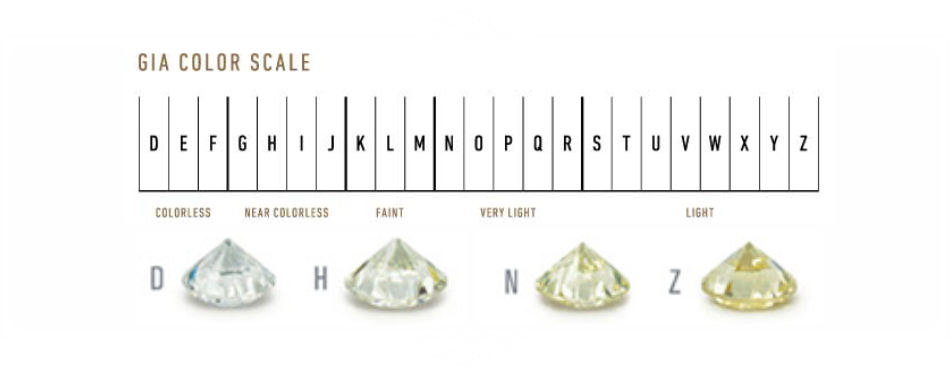The 4 C's of Diamond Quality
Every diamond is unique. Each reflects the story of its arduous journey from deep inside the earth to a cherished object of adornment. Yet all diamonds share certain features that allow us to compare and evaluate them. These features are called the 4Cs.
COLOR
Diamond color is all about what you can't see. Diamonds are valued by how closely they approach colorlessness - the less color, the higher their value. (The exception to this is fancy-color diamonds, such as pinks and blues, which lie outside this color range.)
The GIA Color Scale extends from D (colorless) to Z (light yellow or brown). Although many people think of gem quality diamonds as colorless, truly colorless diamonds are actually very rare. Most diamonds used in jewelry are nearly colorless with tints of yellow or brown.
Color grades are determined by comparing each diamond to a master set. Each letter grade represents a range of color and is a measure of how noticeable a color is.
Fluorescence Some diamonds can emit a visible light when exposed to ultraviolet radiation, but fluorescence is not a factor in determining color or clarity grades. However, a description of its strength and color is provided on GIA Reports as an additional identifying characteristic.
CLARITY

Because diamonds formed deep within the earth, under extreme heat and pressure, they often contain unique birthmarks, either internal (inclusions) or external (blemishes).
Diamond clarity refers to the absence of these inclusions and blemishes. Diamonds without these birthmarks are rare, and rarity affects a diamond's value. Using the GIA International Diamond Grading System™, diamonds are assigned a clarity grade that ranges from flawless (FL) to diamonds with obvious inclusions (I3).
The GIA Clarity Scale includes eleven clarity grades ranging from Flawless to I3. Because diamonds form under tremendous heat and pressure, it is extremely rare to find a diamond that lacks any internal and external characteristics. These characteristics are a byproduct of its formation and help gemologists separate natural diamonds from synthetics and simulants, and identify individual stones.
CUT

Cut is the factor that fuels a diamond's fire, sparkle and brilliance.
A polished diamond's beauty lies in its complex relationship with light: how light strikes the surface, how much enters the diamond, and how, and in what form light returns to your eye.
The result is a magnificent display of three attributes. Brightness is the combination of all white light reflecting from the surface and interior of a diamond. Fire describes the "flares" of color emitted from a diamond. Scintillation describes the flashes of light you see when the diamond, the light, or the observer moves.
A polished diamond's proportions affect its light performance, which in turn affects its beauty and overall appeal. Diamonds with fine proportions, symmetry, and polish optimize their interaction with light, and have increased brightness, fire, and scintillation.
CARAT (WEIGHT)

Diamonds and other gemstones are weighed in metric carats: one carat is equal to 0.2 grams, about the same weight as a paperclip. (Don't confuse carat with karat, as in "8K gold," which refers to gold purity.
Just as a dollar is divided into 100 pennies, a carat is divided into 100 points. For example, a 50-point diamond weighs 0.50 carats. But two diamonds of equal weight can have very different values depending on the other members of the Four C's: clarity, color and cut.
The majority of diamonds used in fine jewelry weigh one carat or less.
Because even a fraction of a carat can make a considerable difference in cost, precision is crucial. In the diamond industry, weight is often measured to the hundred thousandths of a carat, and rounded to a hundredth of a carat. Diamond weights greater than one carat are expressed in carats and decimals. (For instance, a 1.08 ct. stone would be described as "one point oh eight carats," or "one oh eight.")



